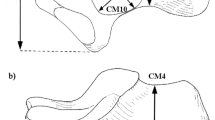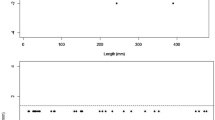Abstract
There are many population-specific studies around the world on sex estimation from skeletal remains. Of the long bones, the tibia has been an important one because it is commonly studied to assess population specificity of a long bone. However, the studies in Europe that use this bone for sex estimation remain limited. The aim of this study is to analyse the tibia in different populations of the southern Europe such as Greece, Italy, and Spain providing standards for sex estimation in a forensic context. In total, we analyzed tibiae of 157 Greek, 190 Italian, and 105 Spanish individuals. Standard osteometric measurements were taken and the data was analyzed using discriminant function statistics. Posterior probabilities were calculated for all produced formulae. Statistical analysis was performed using SPSS subroutines. All measurements were significantly different between the sexes in all three populations and in the pooled sample. A discriminant function of the pooled sample for Southern Europeans resulted in about 88 % accuracy using all three variables. Over 43 % of the individuals were correctly classified at a 0.95 threshold. More work should be done including other Southern European populations to this database to further test the applicability of the method.
Similar content being viewed by others
References
Gray H (1918) Anatomy of the human body. Lea & Febiger, Philadelphia
Bass WM (2005) Human osteology: a laboratory and field manual, 5th edn. Missouri Archaeological Society, Columbia
Byers SN (2002) Introduction to forensic anthropology: a textbook. Allyn and Bacon Publishers, Boston
Krogman WM, İşcan MY (1986) The human skeleton in forensic medicine. Charles C. Thomas, Springfield
France DL (1998) Observation and metric analysis of sex in the skeleton. In: Reichs KJ (ed) Forensic osteology: advances in the identification of human remains. Charles C. Thomas, Springfield, pp 163–86
Spradley MK, Jantz RL (2011) Sex estimation in forensic anthropology: skull versus postcranial elements. J Forensic Sci 56(2):289–96
İşcan MY, Miller-Shaivitz P (1986) Sexual dimorphism in the femur and tibia. In: Reichs KJ (ed) Forensic osteology: advances in the identification of human remains. Thomas, C. C, Springfield, pp 102–111
Holland TD (1991) Sex assessment using the proximal tibia. Am J Phys Anthropol 85:221–227
Kieser JA, Moggi-Cecchi J, Groeneveld HT (1992) Sex allocation of skeletal material by analysis of the proximal tibia. Forensic Sci Int 56:29–36
Işcan MY, Yoshino M, Kato S (1994) Sex determination from the tibia: standards for contemporary Japan. J Forensic Sci 39:785–792
Bruzek J (1995) Diagnose sexuelle à l’aide de l’analyse discriminante appliquée au tibia. Antropol Port 13:93–106
Steyn M, İşcan MY (1997) Sex determination from the femur and tibia in South African whites. Forensic Sci Int 90:111–119
González-Reimers E, Velasco-Vázquez J, Arnay-de-la-Rosa M, Santolaria-Fernández F (2000) Sex determination by discriminant function analysis of the right tibia in the prehispanic population of the Canary Islands. Forensic Sci Int 108:165–17
Šlaus M, Tomičić Z (2005) Discriminant function sexing of fragmentary and complete tibiae from medieval Croatian sites. Forensic Sci Int 147:147–152
López-Costas O, Rissech C, Trancho G, Turbón D (2012) Postnatal ontogenesis of the tibia. Implications for age and sex estimation. Forensic Sci Int 214(1–3):207, e1-11
Kranioti EF, İşcan MY, Michalodimitraki M (2008) Craniometric analysis of the modern Cretan population. Forensic Sci Int 180:110, e111-110.e115
Martin R, Saller K (1959) Lehrbuch der Anthropologie. Gustav Fischer, Stuttgart
Del Rio Muñoz PA (2000) Estudio antropologico-forense, antropométrico y morfológico, de la colección de la escuela de Medicina Legal de Madrid. Universidad de Complutense de Madrid, Facultad de Medicina, Madrid
Mardia KV, Kent JY, Bibby JM (2000) Multivariate analysis. Academic, London, 518 p
Brogdon BG (2006) Forensic aspects of Radiology. In: Spitz WU, Spitz DJ, Clark R, Fisher RS (eds) Spitz and fisher's medicolegal investigation of death: guidelines for the application of pathology to crime investigation 4rth edition Springfield, IL
Masotti S, Succi-Leonelli E, Gualdi-Russo E (2013) Cremated human remains: is measurement of the lateral angle of the meatus acusticus internus a reliable method of sex determination? Int J Legal Med 127(5):1039–44
Ross AH, Ubelaker DH, Kimmerle EH (2011) Implications of dimorphism, population variation, and secular change in estimating population affinity in the Iberian Peninsula. Forensic Sci Int 206(1–3):214, e1-5
Jantz LM (1999) Secular change in long bone length and proportion in the United States, 1800–1970. Am J Phys Anthropol 110(1):57–67
Charisi D, Eliopoulos C, Vanna V, Koilias CG, Manolis SK (2011) Sexual dimorphism of the arm bones in a Modern Greek population. J Forensic Sci 56:10–18
Chapman NE (1997) Evidence for Spanish influence on activity induced musculoskeletal stress markers at Pecos Pueblo. Int J Osteoarchaeol 7:497–506
Wilczak CA (1998) Consideration of sexual dimorphism, age, and asymmetry in quantitative measurements of muscle insertion sites. Int J Osteoarchaeol 8:311–325
Weiss E (2003) Understanding muscle markers: aggregation and construct validity. Am J Phys Anthropol 121:230–240
Weiss E (2004) Understanding muscle markers: lower limbs. Am J Phys Anthropol 125:232–238
Zumwalt AC, Ruff CB, Wilczak CA (2000) Primate muscle insertions: what does size tell you? Am J Phys Anthropol 30:331
Tommasini SM, Nasser P, Jepsen KJ (2007) Sexual dimorphism affects tibia size and shape but not tissue-level mechanical properties. Bone 40(2):498–505
Schiessl H, Frost HM, Jee WS (1998) Estrogen and bone-muscle strength and mass relationships. Bone 22:1–6
Acknowledgments
EK would like to thank Anila Tahiri for her contribution in compiling the database, the Heraklion District Attorney for his permit to study the Greek remains, Mr. C. Kavalos and Mr. K. Maragakis for the demographic and archival information, Messrs S. Kougios and A. Katsounas, autopsy technicians at the Department of Forensic Sciences, University of Crete, for their contribution to cleaning, preserving, and preparing the skeletons for analysis and to Dr. A. Papadomanolakis, Head of the Forensic Department, Ministry of Justice, for providing facilities for the study and storage of the collection. Special thanks to Benjamin Osipov and Helen Langstaff for the linguistic review.
Author information
Authors and Affiliations
Corresponding author
Additional information
An erratum to this article is available at http://dx.doi.org/10.1007/s00414-016-1481-6.
Rights and permissions
About this article
Cite this article
Kranioti, E.F., Apostol, M.A. Sexual dimorphism of the tibia in contemporary Greeks, Italians, and Spanish: forensic implications. Int J Legal Med 129, 357–363 (2015). https://doi.org/10.1007/s00414-014-1045-6
Received:
Accepted:
Published:
Issue Date:
DOI: https://doi.org/10.1007/s00414-014-1045-6




